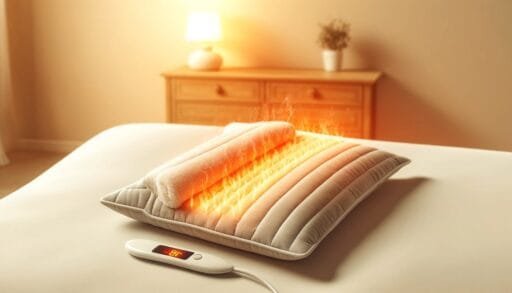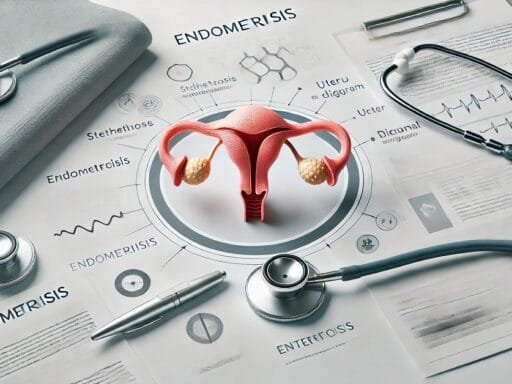1. Introduction
Endometriosis is a chronic condition that affects millions of women worldwide, causing debilitating pain and significantly impacting daily life. This condition occurs when tissue similar to the lining of the uterus grows outside the womb, leading to inflammation, scarring, and severe discomfort. One of the hallmark symptoms is intense pelvic pain, which can become unbearable during menstruation or flare-ups. Managing this pain is a crucial part of improving quality of life for those affected.
While there is no definitive cure for endometriosis, non-invasive methods like heat therapy for cramps have gained popularity for providing effective and immediate relief. Heat has been used for centuries as a natural way to soothe muscle tension, improve circulation, and alleviate discomfort. Among the most trusted solutions is a heating pad for endometriosis pain, which offers targeted relief to the lower abdomen and pelvic region without the need for medications.
Incorporating a heating pad into your pain management routine can be a game-changer. This simple yet powerful tool provides a safe, convenient, and accessible way to address chronic pain and enhance overall well-being. For many women, it has become a go-to option for natural remedies that bring comfort and peace during difficult times.
Table of Contents
2. What is Endometriosis and Why Does It Cause Pain?
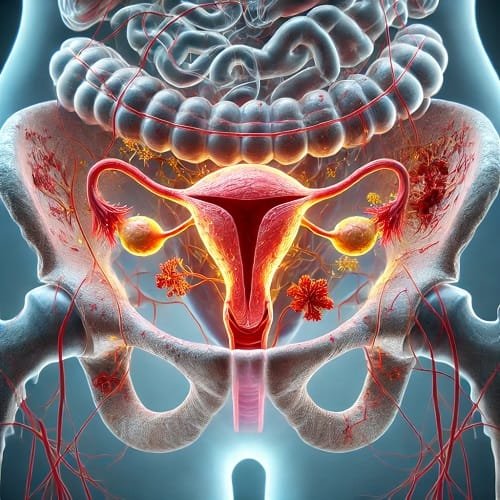
Endometriosis is a chronic condition where tissue similar to the uterine lining grows outside the womb, often attaching to the ovaries, fallopian tubes, or other pelvic structures. This condition affects approximately 1 in 10 women, making it a common cause of severe pelvic pain and menstrual-related issues. For many, finding effective solutions, such as a heating pad for endometriosis pain, becomes essential to manage the discomfort.
The symptoms of endometriosis can vary widely but typically include intense menstrual cramps, chronic back pain, painful periods, and discomfort during intercourse. As the condition progresses, adhesions (scar tissue) can form, causing organs to stick together and worsening the pain. Additionally, chronic inflammation triggered by the condition can further exacerbate symptoms, leading to fatigue and a significant impact on overall well-being.
The pain caused by endometriosis stems from several factors:
- Inflammation: The abnormal tissue releases chemicals that irritate surrounding areas, leading to discomfort.
- Adhesions: Scar tissue can distort pelvic anatomy and intensify pain.
- Nerve involvement: Endometriosis can affect nerves in the pelvic region, sending persistent pain signals.
Given the complexity of this condition, managing the pain is critical for improving daily life. Non-invasive tools, like a heating pad for endometriosis pain, play a significant role in providing fast and effective relief. By reducing muscle tension, improving blood flow, and soothing inflamed areas, these devices offer a simple yet powerful way to achieve much-needed endometriosis relief and enhance overall comfort.
3. Science Behind Heat Therapy for Endometriosis Pain Relief
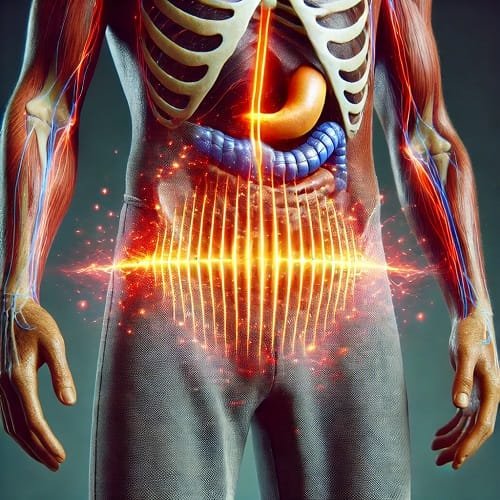
Heat therapy has been a trusted method for managing pain for centuries, and it plays a critical role in alleviating the discomfort caused by endometriosis. The science behind this approach lies in its ability to positively impact the body’s biological processes. Using a heating pad for endometriosis pain provides targeted relief, making it one of the most effective non-invasive solutions available.
Biological Effects of Heat on the Body
- Increased Blood Circulation
Applying heat to the lower abdomen improves blood circulation, delivering oxygen and nutrients to the affected tissues while flushing out toxins. This process helps relax pelvic muscles, reducing tension and easing painful cramps commonly associated with endometriosis. - Pain Receptor Desensitization
Heat therapy temporarily desensitizes pain receptors in the skin and deeper tissues. This effect not only reduces chronic pain but also provides a calming sensation that can improve overall comfort. - Inflammation Reduction
By improving circulation and promoting relaxation, heat helps reduce localized inflammation, which is a key driver of endometriosis-related pain. This makes tools like a heating pad an essential option for those seeking natural pain relief.
Evidence Supporting Heat Therapy
Numerous studies have highlighted the benefits of heat for managing pelvic pain. Research shows that heat therapy can be as effective as certain over-the-counter pain medications for reducing period-related discomfort. This makes it an excellent alternative for those looking to avoid reliance on pharmaceuticals.
Different Forms of Heat Therapy
- Heating Pads: Electric or microwavable heating pads are the most convenient and versatile options for targeting specific areas like the lower abdomen.
- Hot Water Bottles: A traditional choice, these provide consistent warmth but require reheating periodically.
- Infrared Heating Pads: These devices offer therapeutic heat that penetrates deeply into tissues, delivering longer-lasting relief.
Each method has its own unique heat therapy benefits, but a heating pad for endometriosis pain stands out for its ease of use and ability to deliver consistent warmth.
By leveraging heat’s ability to relax muscles, increase blood circulation, and reduce inflammation, women with endometriosis can experience significant relief. Whether it’s to ease cramps, soothe tense pelvic muscles, or manage nerve pain, heat therapy is a reliable and effective part of pain management for this chronic condition.
4. Types of Heating Pads for Endometriosis Pain Relief
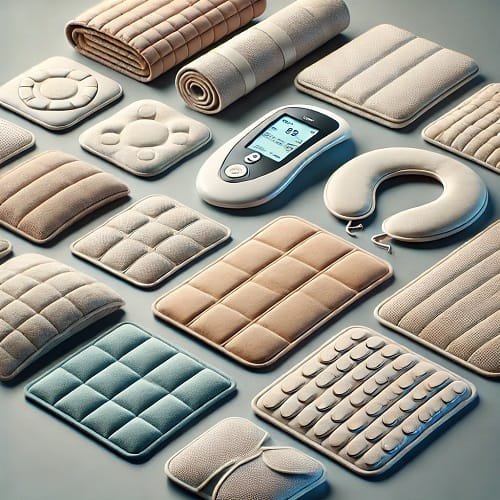
When it comes to managing the discomfort of endometriosis, the type of heating pad you use can make a significant difference. Each type offers unique benefits to suit different lifestyles and preferences. Here’s a breakdown of the most common options, helping you choose the best heating pad for endometriosis pain based on your needs.
1. Electric Heating Pads
Electric heating pads are a popular choice due to their convenience and reliability. They provide consistent heat that can be adjusted to your desired temperature, making them ideal for home use. These pads are excellent for delivering long-lasting warmth to the lower abdomen, relaxing pelvic muscles, and reducing cramps.
- Pros: Adjustable settings, consistent heat, easy to use.
- Cons: Requires access to an electrical outlet and may not be portable.
2. Microwavable Heating Pads
Microwavable heating pads are a great eco-friendly option. These pads are filled with natural materials like rice, flaxseed, or gel, which retain heat after being microwaved. They are lightweight, portable, and ideal for on-the-go use.
- Pros: Reusable, eco-friendly, and easy to heat.
- Cons: Heat retention may be shorter compared to electric options.
3. Wearable Heating Pads
Wearable heating pads are designed for active individuals who need on-the-go relief. These pads come with ergonomic designs that wrap around the lower abdomen or back, allowing users to move freely while receiving warmth. Many models are battery-operated or rechargeable for added convenience.
- Pros: Hands-free, portable, discreet.
- Cons: Limited heat settings, may require frequent recharging.
4. Infrared Heating Pads
Infrared heating pads offer therapeutic heat that penetrates deeply into tissues, providing longer-lasting relief. Unlike traditional heating pads, they use infrared technology to improve blood circulation, reduce inflammation, and target chronic pain effectively.
- Pros: Deeper penetration, effective for severe pain.
- Cons: Typically more expensive than other options.
Tips for Choosing the Right Heating Pad
When selecting a heating pad for endometriosis pain, consider your lifestyle and specific needs:
- At-home use: Opt for an electric heating pad for reliable, consistent heat.
- Eco-friendly options: Choose a microwavable heating pad with natural fillers.
- On-the-go relief: Look for wearable heating pads with a secure fit.
- Chronic pain: Invest in an infrared heating pad for long-lasting, deep relief.
Each type of heating pad offers unique heat therapy benefits, making it easier to find the perfect solution for managing endometriosis symptoms. Whether you prioritize portability, cost-effectiveness, or advanced pain management tools, there’s a heating pad designed to meet your needs.
ALSO READ
Castor Oil for Endometriosis: Proven Benefits & Uses
Menopause and Gastric Reflux: A Comprehensive Guide for Women
Can a Hysterectomy Cure PCOS? A Comprehensive Guide to Treatment
5. How to Use a Heating Pad Safely for Maximum Effectiveness
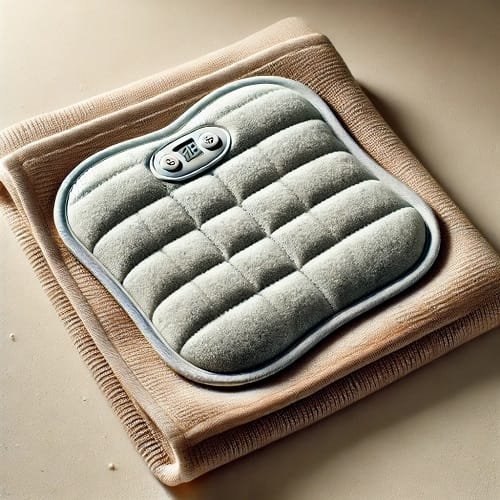
Using a heating pad for endometriosis pain is a simple yet effective way to manage discomfort, but proper usage is essential to maximize its benefits while ensuring safety. Here are some best practices to keep in mind:
Best Practices for Safe and Effective Use
- Set the Ideal Temperature
Always start with a low to medium heat setting to avoid burns. An optimal temperature should feel warm and soothing without causing discomfort. Avoid using high settings for prolonged periods as this can damage the skin. - Limit Usage Time
It’s recommended to use a heating pad for 15–20 minutes per session. Overuse can lead to skin irritation or reduced effectiveness of heat therapy over time. Allow your skin to rest between sessions. - Use Over Clothing
Place the heating pad over a layer of fabric or clothing to ensure skin protection. Direct contact with the skin may cause irritation, especially for those with sensitive skin.
When to Avoid Heat Therapy
Heat therapy is highly effective, but it’s not suitable for every situation. Avoid using a heating pad if you have active inflammation, open wounds, or extremely sensitive skin. If you’re unsure, consult a healthcare professional to determine if heat therapy is appropriate for your condition.
Complementary Practices
To enhance the effects of a heating pad, pair it with natural remedies and healthy practices such as:
- Stretching or yoga: Relieves tension and promotes muscle relaxation.
- Hydration: Reduces inflammation and supports overall well-being.
- Relaxation techniques: Deep breathing or meditation helps manage chronic pain relief holistically.
By following these safety guidelines and combining heat therapy with other forms of complementary care, a heating pad for endometriosis pain can provide significant relief while protecting your health and well-being.
6. Additional Natural Remedies to Complement Heating Pads

While a heating pad for endometriosis pain provides effective relief, combining it with other natural remedies can create a more holistic approach to managing symptoms. Here are additional methods that work synergistically with heat therapy:
1. Anti-Inflammatory Diets
Certain foods have natural anti-inflammatory properties that help reduce endometriosis-related discomfort. Incorporate ingredients like turmeric, ginger, and foods rich in omega-3 fatty acids (such as salmon, walnuts, and chia seeds) into your meals. These anti-inflammatory foods can lower inflammation in the pelvic region and enhance the effects of heat therapy.
2. Gentle Exercises
Practices like yoga and stretching improve blood flow, reduce muscle tension, and support holistic pain management. Gentle movement can complement the soothing warmth of a heating pad, offering additional relief from pelvic pain.
3. Mindfulness and Stress Reduction
Stress can exacerbate flare-ups, so integrating relaxation techniques such as meditation, deep breathing, or mindfulness can help. These practices promote a sense of calm and reduce the body’s pain response, enhancing the benefits of heat therapy.
By pairing a heating pad for endometriosis pain with these remedies, you can create a well-rounded, natural pain management strategy. Together, these methods support long-term flare-up management and improve overall well-being.
8. Frequently Asked Questions (FAQs)
1. Can a heating pad cure endometriosis?
No, a heating pad for endometriosis pain cannot cure the condition. It provides temporary relief by relaxing muscles, improving blood circulation, and reducing cramps, but it does not address the underlying causes of endometriosis. For long-term management, consult a healthcare professional.
2. How often should I use a heating pad for pain relief?
You can use a heating pad 2–3 times a day, with each session lasting around 15–20 minutes. Overusing heat therapy may cause skin irritation, so it’s important to take breaks and follow safe guidelines for heat therapy.
3. Are there any risks of overusing heating pads?
Yes, prolonged or excessive use of a heating pad can lead to skin burns, irritation, or reduced sensitivity over time. To ensure heating pad safety, always follow recommended usage guidelines and avoid sleeping with it on.
4. Can heating pads be used alongside medications?
Absolutely! Heating pads can be safely used alongside pain-relief medications as part of a complementary remedy plan. Together, they provide a multi-faceted approach to managing endometriosis pain.
5. Are infrared heating pads more effective than traditional ones?
Infrared heating pads provide therapeutic heat that penetrates deeper into tissues, making them highly effective for chronic pain relief. However, traditional heating pads are still an excellent and more affordable option for managing pelvic pain. Choose the one that suits your needs best!
9. Conclusion
A heating pad for endometriosis pain is a powerful, non-invasive tool that offers effective relief from one of the most challenging symptoms of endometriosis—chronic pelvic pain. By increasing blood circulation, reducing muscle tension, and providing soothing warmth, heating pads can bring immediate comfort and enhance overall well-being. They are not just simple and accessible but also a proven method of managing pain naturally.
While heating pads cannot cure endometriosis, they play a vital role in comprehensive pain management. Whether used alongside medical treatments or combined with self-care tools like stretching, relaxation techniques, and an anti-inflammatory diet, they help women regain control over their daily lives. Options like electric, microwavable, and infrared heating pads allow you to choose what works best for your needs and lifestyle.
Endometriosis is a complex condition, and finding the right combination of therapies is key to long-term relief. Consult your healthcare provider for a personalized, holistic approach that includes tools like heating pads. Remember, managing pain is not just about the physical aspect but also about embracing self-care and fostering hope for better days ahead.With the right support and non-invasive solutions, you can navigate endometriosis with strength and confidence, improving your quality of life one step at a time.
